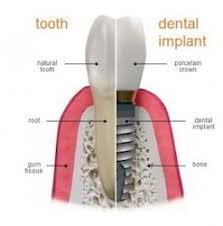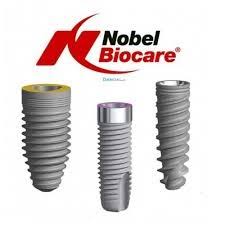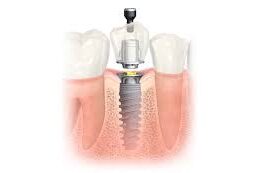The use of a Dental Implant to restore a missing tooth is becoming a popular practice in Kathmandu Nepal. At Shangrila Dental Clinic Kathmandu, the Dental Implant is placed by Dr. Hema Jha. She is a specialist in Prosthodontics and Implantology.
Dental Implant is screw-like tooth root replacements that are placed inside the jawbone. After a few months, we place a crown over that implant.
At Shangrila Dental Clinic, we use Nobel Biocare Dental Implants. They are the pioneers of Dental Implant and the most trusted dental implant brand in the world.



One should never ignore missing or badly damaged teeth. It can negatively impact our appearance as well function.
A missing tooth causes:
- The adjacent teeth shift. Even the opposing tooth ends up becoming longer. This affects our bite.
- The efficiency to chew hard food is decreased. Our diet becomes restricted.
- The bone around the missing tooth starts to diminish. If there are multiple missing teeth, the jawbone starts to shrink and the face looks collapsed.
- Loss of self-confidence to laugh or even smile openly in public.
Treatment options for missing tooth
- Removable partial denture: a plastic tooth is fixed in a pink-colored plate which is then placed in your mouth. You have to remove them at night and keep them in a vessel filled with water. Its only advantage is its cost. The disadvantage is that it is bulky and needs to be removed every night.
- Fixed partial denture popularly known as ‘Bridge’. Generally, the two adjacent teeth next to the missing tooth are prepared for the fixture. In some cases, support of more than 2 teeth is needed. These multiple units of artificial teeth are then cemented back into your mouth.
The advantage is that it is fixed to your teeth and does need not to be removed. The disadvantage is that the adjacent teeth need to be prepared to use as a support. The cost varies on the number of teeth needed for support and the material choice for the bridge. Zirconia bridges are stronger but more expensive compared to the metal-ceramic bridge.
- The third option is a Dental Implant-supported crown. A space is created in the missing tooth region and a dental implant is placed. A crown is placed over that dental implant. The advantage of a dental implant-supported crown is that it prevents further bone loss. In addition, adjacent teeth do not need to be prepared. The disadvantage is the cost. Severely medically-compromised patients are also not a suitable candidate.
Dental Implant Procedure
1. Schedule a Consultation with Your Dentist
Once you’ve decided on dental implants to replace your missing or damaged tooth (or teeth), you’ll have an initial consultation with your dentist. The first thing you’ll discuss is what type of dental implants you need.
The dentist will also take X-rays (or perhaps even use 3D imaging of your mouth and teeth), and create an impression to use in the placement of the implant. Additionally, they will determine if your jaw bone is strong enough to withstand the implant. If not, bone grafting options will be discussed.
2. Have the Damaged Tooth Removed
If you are replacing a tooth that’s cracked or damaged beyond repair, you’ll need to have that tooth pulled. This is a procedure in itself and will at least require a local anesthetic and some time to heal.
3. Bone Grafting for Dental Implants
If your existing jaw bone is not strong enough or lacks the amount of bone needed to hold an implant, your dentist will use a synthetic bone-grafting material. Once the bone graft is in place, it will take four months to a year to heal and be ready to accommodate the implant. And in some cases, if you need only minor bone grafting, the procedure can be done at the same time as the implant surgery.
4. Dental Implant Placement
Once you have healed from any necessary tooth removal and bone grafting, your dentist will place the implant in your jawbone. This titanium screw serves as the tooth root and is implanted beneath the gum line. (You won’t be able to feel it while it is healing.) Generally, it will take four to six months for the implant to properly fuse (a process known as osseointegration) with the jawbone.
5. Healing Cap Placement
When the implant is securely fused with the jawbone, your dentist will place a healing cap at the end of the implant — flush with your gum. This acts as sort of a metal collar, guiding the gum tissue to heal around the cap in preparation for the attachment of the abutment and crown. This process typically takes 10 to 14 days to heal.
6. Abutment and Temporary Crown Placement
After the tissue around the cap heals, it is removed and replaced by the dental implant abutment. The abutment is screwed onto the implant.
7. Permanent Crown Placement
While you’re wearing the temporary crown, the permanent crown will be made. It may take two weeks to make a permanent crown. The crown can be either cemented or screwed to the abutment.
Crowns held in place by cement may look better because there is no screw hole in the crown to be seen. However, crowns held in place by a screw are easier for your dentist to remove if he or she needs to reach the implant or the tissue surrounding the implant.
While the entire dental implant procedure takes time, each of the steps is manageable. Generally speaking, only a local anesthetic is necessary. After the procedure, it’s possible that you’ll experience some swelling and soreness around the jaw, but most likely, a little discomfort.
Of course, each patient’s circumstances are different, and each dentist’s treatment style may vary slightly. Regardless, the more you know about what to expect, the easier it will be to plan for the procedure and have the most successful experience — with the fewest surprises
To manage the pain that you might experience during the dental implant procedure, your dentist will administer local anesthesia.
Managing Post Dental implant Surgery Discomfort
Your dentist will prescribe a painkiller to be taken immediately after surgery to alleviate any discomfort from the anesthesia wearing off. If so, don’t forget to take it with food to avoid nausea.
Watch out for Dental Bleeding
Immediately following your surgery, you may experience some bleeding in the area around your implants. This is a common dental implant side effect and typically subsides within 24 hours. Check-in with your dentist if you have any concerns.
Don’t be surprised by Facial Bruising
After dental implant surgery, you may notice bruises on your neck, gums, or jaw. Within days, the discoloration should subside, and within 2-3 weeks, your face should feel much better.
Some Swelling and Soreness May Occur
Another potential dental implant issue is soreness and swelling around the jaw and gums. This may last up to one week, and symptoms may be alleviated by applying a cold wrap or ice pack.
Avoid Smoking after Dental Implant Surgery
It’s important not to smoke right after dental implant surgery, as it can slow down the healing process and extend the amount of time you have to wait for your dental implants to be ready for use.
Watch What You Eat after Surgery
Here are some things to avoid:
- Alcohol, which can delay the healing process
- Spicy foods, which may irritate the incision site
- Crunchy foods, which can be difficult to chew
- Popcorn, candy, nuts, sesame seeds, and any other foods that might lodge in the incision site
- Hot food and drinks that could burn any part of your mouth
Also, try to avoid chewing on the side of the mouth that has the implant for at least the first couple of days.
Keep up with Your Oral Hygiene
After each step of your dental implant process, it’s especially important to keep your mouth clean. You can carefully brush your teeth as soon as the night of your surgery, but avoid the surgical area for the first couple of days. Additionally, gently rinse your mouth out with lukewarm saltwater, starting 24 hours after surgery. Try swishing the water around, and instead of spitting, let it drip out of your mouth and into the sink. Rinses should be done two to three times a day, especially after eating.
It’s important to remember, that not everyone reacts the same way to dental implants. Be sure to follow your dentist’s advice.
Is dental-implant-supported crown becoming popular in Kathmandu Why?
Even though the price is slightly higher for a dental implant, many people are preferring it over the traditional bridges. The main reason is people don’t like to have their adjacent healthy teeth prepared to use as support. The cost of a dental implant-supported crown is comparable to a zirconia bridge.
Pros of Dental Implant
- Aesthetics: If you want an “Insta-ready” smile, dental implants may be the right choice. They look and feel just like regular teeth.
- Bone health: When you get dental implants, the implant is replacing the root of your tooth. This means that — although it is still possible — bone loss is much less likely.
- Durability: Because the implants are fused to your jaw bone, they’re very stable, and if you take good care of them, you can expect them to be just as durable as your natural teeth.
- Practical benefits: Because the implant’s titanium post is fused to your jaw, implants stay in place. That means (unlike dentures) your speech is not affected and eating is easier.
Cons of Dental Implant
- Lengthy process: Getting dental implants fitted can take a long time, as you’ll need to wait up to six months for your implants to fuse with the jawbone. Given that there are multiple steps involved this may not be the best solution for someone who needs an immediate fix.
- Infections: Although dental implant complications are rare, it’s possible for your gums to get infected after implant surgery known as Peri-implantitis.
- Additional procedures: In some cases, dental implants may require additional procedures. For example, some people may require a bone graft. It’s also possible that you may need a sinus lift if your sinuses are located too close to your jawbone. These additional surgeries can increase waiting time for your implants, while they may also ramp up the price.
- Cost: You can expect to pay more for this type of procedure than you would for any typical dental treatment.
So, is dental implant surgery worth all the trouble?
Owing to their durability, appearance, and functionality, dental implants are probably the best option for missing teeth replacement, giving you a long-term option that can last for the rest of your life.
Want to make an appointment? Contact Shangrila Dental Clinic at 01-4423123 0r 9841815537

